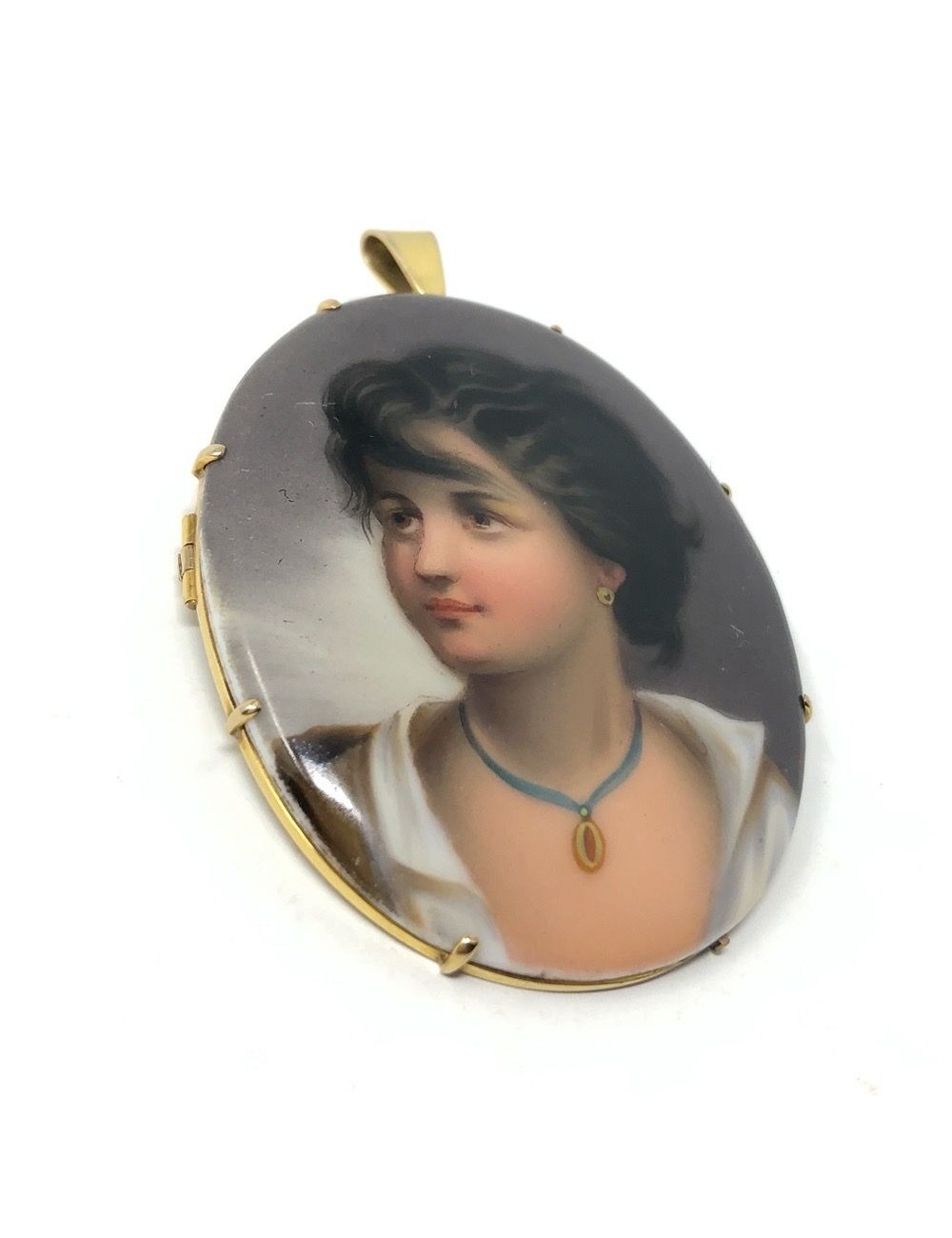- On sale!
- -25%










This wonderful example of Victorian jewellery was created in 1876. It can be worn as a pendant or a brooch.
Condition Report:
Excellent
For more information about this piece, read below...
The Details...
Constructed from 9ct gold, this pendant features an oval porcelain plaque hand-painted with a miniature portrait. The reverse of the plaque is signed by the artist. Their name is difficult to decipher due to ageing. However, their initials appear to be L and M. It is dated 1876. The piece features a bail, so that it can be worn as a pendant. It also features a fastening mechanism, so that it may be worn as a brooch. The pin is attached to the brooch with a tube hinge and the brooch fastens with a traditional safety catch. The piece measures 5.5cm x 4.5cm.
A Short History...
Whilst the portrait in this piece may appear to depict a young girl with windswept hair, it is actually a portrait inspired by a painting by German artist Gustav Carl Ludwig Richter (1861-1897) entitled 'Neapolitan Fisher Boy'. In the painting, Richter shows a boy with short billowing black hair, an open shirt and jewellery, as can be seen in this piece. Hand-Painted porcelain plaques (most notably by the makers KPM) were made in Germany re-creating Richter's famous work, therefore this piece is likely to have originated in Germany too.
Wear it With...
Add this pendant to your favourite chain and perhaps add other charms to compliment it.
The jewellery within the Gemma Redmond Vintage collection has survived to this day because it has been well cared for throughout its lifetime. It is important to continue to care for the jewellery that you buy from us to ensure its continued preservation. Here are some suggestions:
- Be sure to store your jewellery within the boxes that we provide to ensure that it is protected. This is especially important when travelling with your pieces.
- Try not to get perfume or hairspray on your items. These liquids can damage the materials that our jewellery is made from.
- Try not to drop your jewellery or catch your jewellery against hard surfaces. If this happens over time, the findings and fixings can loosen and wear.
- Try not to get your jewellery wet. Some costume jewellery manufacturers utilised water soluble glue in the making of their pieces. Getting your jewellery wet could cause rhinestones and other details to fall away over time.
- If you wish to clean your jewellery, use a soft polishing cloth or a soft brush.
This wonderful example of Françoise Montague jewellery dates from c.1962.
Condition Report:
Excellent
For more information about this necklace, read below...
This necklace exudes beautiful quality and design. It was created in the 1950s in Germany.
Condition Report:
Excellent
For more information about this necklace, read below...
This chic necklace dates from the 1980s. It was sourced in France and was most liely created there too.
Condition Report:
Excellent
To learn more about this necklace, read below...
This lovely necklace, reflects the craftsmanship and eye for detail characteristic of Czechoslovakian jewellery design. It dates from the 1930s.
Condition Report:
Excellent
For more information about this necklace, read below...
This striking necklace features high quality details and design. It dates from the 1970s and is unsigned.
Condition Report:
Excellent
For more information about this necklace, read below...
This beautiful necklace, reflects the craftsmanship and eye for detail that is characteristic of Czechoslovakian jewellery design.
Condition Report:
Very Good - A tiny element of scratching to the surface of the central glass stone on the pendant. This is only visible upon close inspection with a magnifying glass. It does not detract from the appeal of the piece.
For more information about this necklace, read below...
This lovely necklace, reflects the craftsmanship and eye for detail characteristic of Czechoslovakian jewellery design. It dates from the 1930s.
Condition Report:
Excellent
For more information about this necklace, read below...
This elegant Christian Dior necklace was made in the 1990s when John Galliano was designing for the French fashion house.
Condition Report:
Excellent
For more information about this necklace, read below...
This rare design glass bead necklace represents elegant Art Deco craftsmanship.
Condition Report:
Excellent - The necklace has been professionally re-strung.
For more information about this necklace, read below...
This beautiful black glass locket is an entirely original, elegant antique.
Condition Report:
Very Good - There is a tiny chip to the edge of one circular and one triangular panel. This is only visible upon very close inspection and does not detract from the overall appeal of the piece.
For more information about this necklace, read below...
This elegant necklace reflects the craftsmanship and eye for detail characteristic of Czechoslovakian jewellery design.
Condition Report:
Excellent
For more information about this necklace, read below...
This stylish necklace dates from the 1930s and was created by Jakob Bengel.
Condition Report:
Excellent
For more information about this necklace, read below...
This lovely and wearable example of a glass bead Art Deco necklace was most likely created in France.
Condition Report:
Excellent
For more information about this necklace, read below...
Although unsigned, this necklace is highly likely to have been created in Limoges, France, in the 1950s.
Condition Report:
Excellent
For more information about this bracelet, read below...
This stylish necklace was made in the 1990s in France by the Inès de La Fressange brand.
Condition Report:
Excellent
For more information about this necklace, read below...
This beautiful pendant was created in the 1800s.
Condition Report:
Very Good - Some darkening in colour to the central paste stone. This is consistent with age and does not detract from the appeal of this rare piece.
For more information about this pendant, read below...

This wonderful example of Victorian jewellery was created in 1876. It can be worn as a pendant or a brooch.
Condition Report:
Excellent
For more information about this piece, read below...